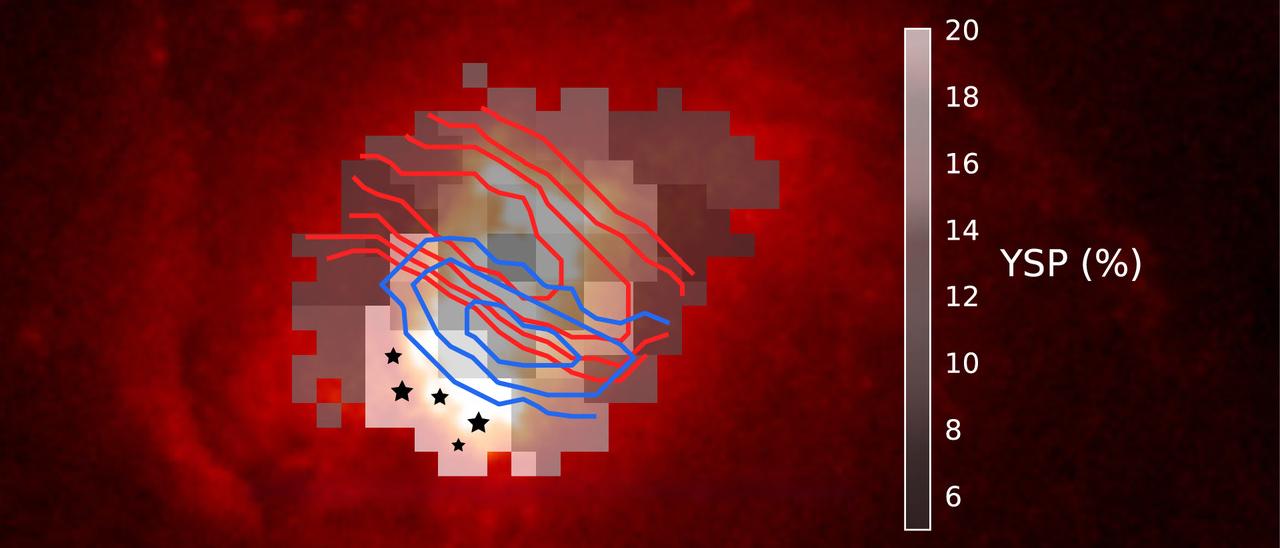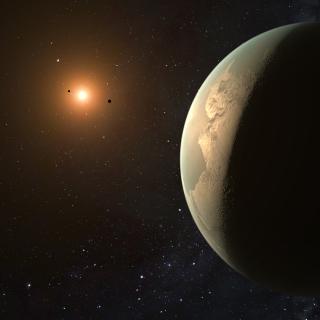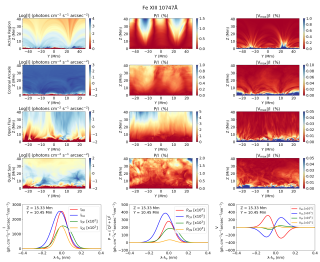Winds launched by a supermassive black hole impact the formation of new stars in the galaxy Markarian 34. The fraction of light coming from a young stellar population (YSP) increases at the edges of the approaching side of the wind (blue contours) compared to the rest of the galaxy. The receding side of the wind, faster and more turbulent (red contours), might be preventing star formation. Credits: HST/MAST Archive and G. Pérez Díaz.
Patricia Bessiere, a researcher at the Instituto de Astrofísica de Canarias (IAC), has led research which has used data from the KECK telescope in Hawaii to understand the impact that active galactic nuclei have on star formation in their host galaxies. The results are published today in the journal Monthly Notices of the Royal Astronomical Society Letters.
One of the key questions that astronomers are trying to answer is ‘Why do galaxies look the way they do?’. Computer simulations of how galaxies formed and evolved suggest that there should be many more very large galaxies than we actually observe, so what is the missing ingredient in these simulations? What is the process within galaxies that stops too many stars from forming?
We now know that all massive galaxies harbour a super massive black hole at their heart, which is millions or billions of times heavier than our own sun. When the amount of gas from within the galaxy falling onto the black hole abruptly increases, it becomes incredibly hot and vast amounts of energy are released into the galaxy. When a black hole is going through such a phase, it is known as an Active Galactic Nucleus or AGN and astronomers believe that this phenomenon may be the missing ingredient they have been searching for. Some of the energy released by the AGN will have the effect of pushing the gas out of the galaxy, a process known as 'AGN driven winds' or 'AGN feedback', which means that there will be less gas from which to form new stars.
A team of scientists at the IAC have been trying to catch this process in action. Using integral field spectroscopy (IFS) from the KCWI instrument on the Keck telescope in Hawaii, which allows astronomers to simultaneously take many spectra at different locations in the galaxy, they have been able to map both the AGN driven winds and the ages of stars across the inner region of the well studied active galaxy Markarian 34. Taking this approach, they hoped to understand if these winds were having a direct impact on star formation. The results of this study are published today in Monthly Notices of the Royal Astronomical Society Letters as part of the “QSOFEED” project (http://research.iac.es/galeria/cra/qsofeed/) whose aim is to understand how supermassive black holes affect the galaxies that host them.
What the team found shows that that AGN and the winds that they drive have a complex impact on their host galaxies. On one side of the galaxy, they have shown that ahead and at the edges of the wind, new stars are being formed. Patricia Bessiere, who led the study, explains why this may be happening. “Some theoretical studies and computer simulations suggest that, as the AGN driven wind passes through the galaxy, the denser, cooler gas ahead and to the sides is compressed, making the conditions for star formation more favourable. This means that the wind is actually triggering star formation rather than suppressing it.”
However, on the other side of the galaxy, the rate of star formation is found to be unaffected by the passage of the wind. The team suggest that this might be because the wind here is faster and more turbulent meaning that the conditions for star formation are not similarly enhanced. Cristina Ramos Almeida, an IAC researcher and co-author of the study, explains that “what we are seeing here may be evidence of ‘preventive’ feedback, meaning that the wind is disrupting the gas in the galaxy so that it can’t collapse to form new stars”.
“This study demonstrates that the relationship between AGN and their host galaxies is complex and can impact different regions in different ways. The findings of this observational investigation will be important in informing future modelling of galaxy evolution and the role played by AGN”, explains Patricia Bessiere.
To expand our understanding of this relationship, the team now plan to extend their study by observing a larger sample of AGN using the MEGARA instrument, installed on the 10 m Gran Telecopio CANARIAS (GTC). This will allow the team to obtain IFS data which they will use to characterise the spatial distribution of both the winds and the stellar populations. This will help astronomers to understand the details of the relationship between the AGN and star formation and, importantly, how common such interactions are.
Article: P. S. Bessiere, C. Ramos Almeida. Spatially resolved evidence of the impact of quasar driven outflows on recent star formation: The case of Mrk 34. Monthly Notices of the Royal Astronomical Society: Letters, Volume 512, Issue 1, Pages 54–59. DOI: https://doi.org/10.1093/mnrasl/slac01
IAC contacts:
- Patricia Bessiere (pbessiere [at] iac.es (pbessiere[at]iac[dot]es))
- Cristina Ramos Almeida (cra [at] iac.es (cra[at]iac[dot]es))





